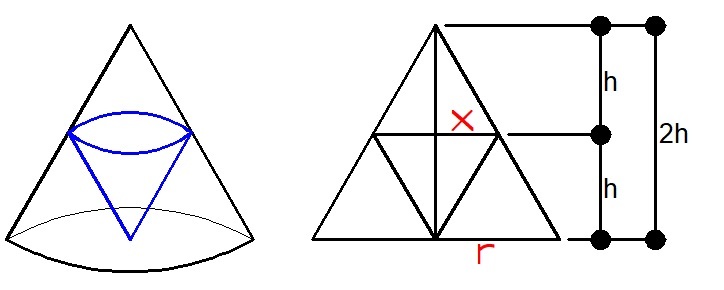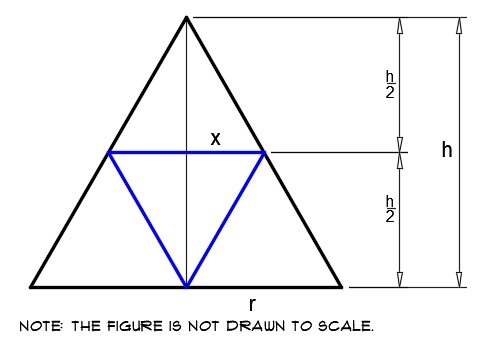Divine Conedy
A cone has a volume of 48 units.
Inside the cone we place a second, smaller cone, as shown in the drawing.
-
The tip of the small cone touches the center of the large cone's base.
-
The circumference of the small cone's base lies on the large cone's mantle, precisely halfway up the large cone.
How much is the volume of the smaller cone?
This section requires Javascript.
You are seeing this because something didn't load right. We suggest you, (a) try
refreshing the page, (b) enabling javascript if it is disabled on your browser and,
finally, (c)
loading the
non-javascript version of this page
. We're sorry about the hassle.
5 solutions
 Consider my diagram. Let
r
and
x
be the radii of the big cone and small cone, respectively. The volume of the bigger cone is
Consider my diagram. Let
r
and
x
be the radii of the big cone and small cone, respectively. The volume of the bigger cone is
4 8 = 3 1 ( π ) ( r 2 ) ( 2 h ) ⟹ π r 2 h = 7 2 ( 1 )
Now we solve x in terms of r , by similar triangles, we have
h x = 2 h r ⟹ x = 2 r ( 2 )
The volume of the smaller cone is
V = 3 1 ( π ) ( x 2 ) ( h )
Substituting ( 2 ) , we have
V = 3 1 ( π ) ( 2 r ) 2 = 1 2 1 π r 2 h
Substituting ( 1 ) , we have
V = 1 2 1 ( 7 2 ) = 6
As the two cones are similar, it implies that if k is the ratio between the h e i g h t of the small cone to the large cone then the volume V s of the small cone is k 3 1 V l where V l is the volume of the large cone. V s = 2 3 1 × 4 8 V s = 8 1 × 4 8 V s = 6
This problem is the same as the first problem in this series, only slightly restated. Since the correct answer to the first problem held that the small cone contained 1/8 the volume of the large cone, it was easy to determine the small cone would contain 1/8 of 48 units, or 6 units.
 Formula:
v
=
3
1
A
h
where
A
is the area of the base and
h
is the height.
Formula:
v
=
3
1
A
h
where
A
is the area of the base and
h
is the height.
4 8 = 3 1 π r 2 h ⟹ r 2 h = π 1 4 4 ( 1 )
By similar triangles, 2 h x = h r ⟹ x = 2 r ⟹ x 2 = 4 r 2 ( 2 )
Substituting ( 1 ) and ( 2 ) into the formula, the volume of the small cone is
v = 3 1 π x 2 2 h = 6 1 π x 2 h = 6 1 π ( 4 r 2 ) h = 2 4 π r 2 h = 2 4 π ( π 1 4 4 ) = 6
Clearly, the smaller cone has half of the height of the larger cone.
Also, the base of the smaller cone must have half of the diameter of the base of the larger cone, in order to fit snugly halfway up the large cone.
Thus, the small cone is half the size in all three dimensions; it has ( 1 / 2 ) 3 = 1 / 8 of the volume of the large cone.
Finally, 4 8 ⋅ 1 / 8 = 6 units.